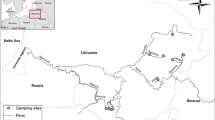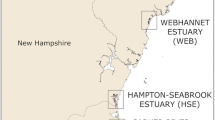Abstract
Recruitment of the European eel (Anguilla anguilla) has fallen steadily in recent decades, with current levels understood to be at around 5 % of those in the 1970s, and the species is now widely recognised as being endangered. Changes in ocean currents, climate shifts, habitat loss, overfishing, barriers to migration, increased predation, plastic litter and exposure to chemicals have all been postulated as potential causative factors. Several studies have shown a general decline in eel quality (lower lipid content and body condition) over time that may be linked to reduced reproductive success. In this study, data from an eel sampling campaign in 1987 are compared with recent data (2004–2008) for eels in Scotland to assess any temporal changes in eel quality indicators and also to assess any links between current levels of chemical exposure and eel quality. Mean lipid levels, as a percentage of wet muscle mass, were higher in 2004–2008 (37 ± 1.9 % SE) than in 1986 (21 ± 0.9 % SE). By contrast, mean body condition index (K) was slightly lower in the latter period. Considering the 2004–2008 samples, significant inter-site variation was observed for condition index K, while intra-site variation was observed for lipid content and physical parameters relative to age (i.e. mass/age, length/age and lipid/age ratios); however, the variations observed could not be linked to differences in chemical body burdens, indicating that no chemical impacts on the parameters assessed are discernible during the continental life stage of eels in Scotland.






Similar content being viewed by others
References
Adams CE, Godfrey JD, Dodd JA, Maitland PS (2013) Is proximity to the North Atlantic Drift and the Continental Shelf Current sustaining freshwater European eel populations in west Scotland? Freshw Biol 58:1–9
Anderson H, Futter M, Oliver IW, Redshaw CJ (2010) Trends in Scottish river water quality. Macaulay Land Use Research Institute and Scottish Environment Protection Agency, Edinburgh
Andersson J, Sandström O, Hansen HJM (1991) Elver (Anguilla anguilla L.) stockings in a Swedish thermal effluent-recaptures, growth and body condition. J Appl Ichthyol 7:78–89
Belpaire C, Geeraerts C, Evans D, Ciccotti E, Poole R (2011) The European eel quality database: towards a pan-European monitoring of eel quality. Environ Monit Assess 183:273–284
Belpaire CGJ, Goemans G, Geeraerts C, Quataert P, Parmentier K, Hagel P, De Boer J (2009) Decreasing eel stocks: survival of the fattest? Ecol Freshw Fish 18:197–214
Boetius I, Boetius J (1980) Experimental maturation of female silver eels, Anguilla anguilla. Estimates of fecundity and energy reserves for migration and spawning. Dana 1:1–28
de Boer J, Dao QT, van Leeuwen SPJ, Kotterman MJJ, Schobben JHM (2010) Thirty year monitoring of PCBs, organochlorine pesticides and tetrabromodiphenylether in eel from The Netherlands. Environ Pollut 158:1228–1236
de Boer J, Hagel P (1994) Spatial differences and temporal trends of chlorobiphenyls in yellow eel (Anguilla anguilla) from inland waters of the Netherlands. Sci Total Environ 141:155–174
Dekker W, Pawson M, Wickstrom H (2007) Is there more to eels than slime? An introduction to papers presented at the ICES Theme Session in September 2006. ICES J Mar Sci: J Conseil 64:1366–1367
DIONEX (2011) Rapid determination of fat in meat using Accelerated Solvent Extraction (ASE)—Application Note 334
Dosoretz C, Degani G (1987) Effect of fat rich diet and temperature on growth and body composition of European eels (Anguilla anguilla). Comp Biochem Physiol A Physiol 87:733–736
EC (European Commission) (2000) Directive 2000/60/EC (the Water Framework Directive) of the European Parliament and of the Council of 23 October 2000 establishing a framework for Community action in the field of water policy. Off J Eur Communities L327(2000):1–72
EC (European Commission) (2007) Council Regulation (EC) No 1100/2007 of 18 September 2007 establishing measures for the recovery of the stock of European eel. Offic J European Union 22.9.2007 L 248:17–23
Ferrante MC, Clausi MT, Meli R, Fusco G, Naccari C, Lucisano A (2010) Polychlorinated biphenyls and organochlorine pesticides in European eel (Anguilla anguilla) from the Garigliano River (Campania region, Italy). Chemosphere 78:709–716
Freyhof J, Kottelat M, (2008) Anguilla anguilla, International Union for Conservation of Nature (IUCN) Red List of Threatened Species 2010
Froese R (2006) Cube law, condition factor and weight–length relationships: history, meta-analysis and recommendations. J Appl Ichthyol 22:241–253
Geeraerts C, Focant JF, Eppe G, De Pauw E, Belpaire C (2011) Reproduction of European eel jeopardised by high levels of dioxins and dioxin-like PCBs? Sci Total Environ 409:4039–4047
ICES (2006) Report of the 2006 session of the Joint EIFAC/ICES Working Group on Eels. Rome, 23–27 January 2006. EIFAC occasional paper 38. ICES CM 2006/ACFM:16
ICES (2009) Workshop on age reading of European and American eel (WKAREA), 20–24 April 2009, Bordeaux, France. ICES CM 2009\ACOM: 48. pg 66 International Council for the Exploration of the Sea (ICES)
ICES (2011) Report of the 2011 Session of the Joint EIFAAC/ICES Working Group on Eels, Lisbon, Portugal, 5–9 September 2011. EIFAAC occasional paper 48. ICES CM 2011/ACOM:18
Knights B (2003) A review of the possible impacts of long-term oceanic and climate changes and fishing mortality on recruitment of anguillid eels of the Northern Hemisphere. Sci Total Environ 310:237–244
Larsson P, Hamrin S, Okla L (1991) Factors determining the uptake of persistent pollutants in an eel population (Anguila anguilla L.). Environ Pollut 69:39–50
Love RM (1970) The chemical biology of fishes. Academic, London, p 547
Macgregor K, Oliver IW, Harris L, Ridgway IM (2010) Persistent organic pollutants (PCB, DDT, HCH, HCB & BDE) in eels (Anguilla anguilla) in Scotland: current levels and temporal trends. Environ Pollut 158:2402–2411
McHugh B, Poole R, Corcoran J, Anninou P, Boyle B, Joyce E, Barry Foley M, McGovern E (2010) The occurrence of persistent chlorinated and brominated organic contaminants in the European eel (Anguilla anguilla) in Irish waters. Chemosphere 79:305–313
Oliveira Ribeiro CA, Vollaire Y, Sanchez-Chardi A, Roche H (2005) Bioaccumulation and the effects of organochlorine pesticides, PAH and heavy metals in the Eel (Anguilla anguilla) at the Camargue Nature Reserve, France. Aquat Toxicol 74:53–69
Perneger TV (1998) What's wrong with Bonferroni adjustments. Br Med J 316:1236–1238
Roose P, Van Thuyne G, Belpaire C, Raemaekers M, Brinkman UAT (2003) Determination of VOCs in yellow eel from various inland water bodies in Flanders (Belgium). J Environ Monit 5:876–884
Szlinder-Richert J, Usydus Z, Pelczarski W (2010) Organochlorine pollutants in European eel (Anguilla anguilla L.) from Poland. Chemosphere 80:93–99
Tesch FW (2003) In: Thorpe JE (ed) The eel. Blackwell Science, Oxford, 408 pp
Van Den Berg M, Birnbaum L, Bosveld ATC, Brunstrom B, Cook P, Feeley M, Giesy JP, Hanberg A, Hasegawa R, Kennedy SW, Kubiak T, Larsen JC, Van Leeuwen FXR, Liem AKD, Nolt C, Peterson RE, Poellinger L, Safe S, Schrenk D, Tillitt D, Tysklind M, Younes M, Waern F, Zacharewski T (1998) Toxic equivalency factors (TEFs) for PCBs, PCDDs, PCDFs for humans and wildlife. Environ Health Perspect 106:775–792
van Ginneken V, Palstra A, Leonards P, Nieveen M, van den Berg H, Flik G, Spanings T, Niemantsverdriet P, van den Thillart G, Murk A (2009) PCBs and the energy cost of migration in the European eel (Anguilla anguilla L.). Aquat Toxicol 92:213–220
Wells DE, Cowan AA, Christie AEG (1987) A survey of organochlorine residues and related compounds in the European eel, Anguilla anguilla in Scottish fresh waters between September 1986 and February 1987. Report to the working party on pesticide residues (sub-group on wildlife and the environment)
Acknowledgments
The authors acknowledge the contribution of SEPA field staff involved in eel collection and the support of technical staff in the Trace Organics laboratory. In addition, the work of Iain McLaren (Marine Science Scotland) in relation to eel age determination is gratefully acknowledged.
Conflict of interest
Any opinions expressed in this article are those of the authors and are not necessarily those of their host organisations.
Author information
Authors and Affiliations
Corresponding author
Additional information
Responsible editor: Roland Kallenborn
Electronic supplementary material
Below is the link to the electronic supplementary material.
Supplementary Information Table 1
(DOC 76 kb)
Supplementary Information Table 2
(DOC 75 kb)
Supplementary Information Table 3
(DOC 49 kb)
Supplementary Information Table 4
(DOC 64 kb)
Rights and permissions
About this article
Cite this article
Oliver, I.W., Macgregor, K., Godfrey, J.D. et al. Lipid increases in European eel (Anguilla anguilla) in Scotland 1986–2008: an assessment of physical parameters and the influence of organic pollutants. Environ Sci Pollut Res 22, 7519–7528 (2015). https://doi.org/10.1007/s11356-015-4116-4
Received:
Accepted:
Published:
Issue Date:
DOI: https://doi.org/10.1007/s11356-015-4116-4




